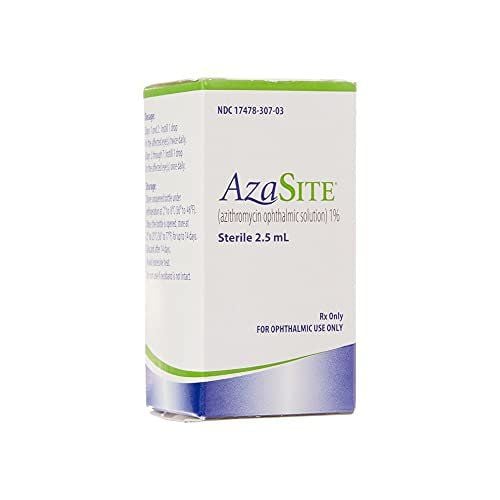This is an automatically translated article.
Frazix is prescribed mainly to treat bacterial infections, such as metritis, pharyngitis, tonsillitis, urethritis, impetigo,... During the course of Frazix use, patients It is important to strictly follow the instructions of the doctor to take the medicine to recover quickly.1. What is Frazix?
Frazix belongs to the group of minerals and vitamins, is formulated in the form of an oral powder to effectively treat respiratory infections, sinusitis, bronchitis, impetigo, boils, metritis, urethritis. and some other infections.In each box of Frazix pills, there are 6 packs, each pack contains the following active ingredients:
Pharmaceutical ingredients: Azithromycin 250mg. Excipients: Aerosil, Sucrose, Aspartame and strawberry flavor powder. Frazix is available as prescribed by your doctor at a dose and frequency based on the severity of the infection. Patients need to strictly follow the treatment regimen with Frazix recommended by the doctor to soon improve the disease.
2. What are the effects of Frazix?
2.1. Uses of the active ingredient Azithromycin
Azithromycin is a semi-synthetic antibiotic belonging to the Macrolide group, with antibacterial activity due to binding to the ribosomes of pathogenic bacteria and inhibiting their protein synthesis. Structurally, Azithromycin differs from Erythromycin by the presence of a Nitrogen atom replacing the Methyl group on the Lactone ring. Therefore, chemically, Azithromycin belongs to the Azalide group.According to research, Azithromycin has a very good antibacterial effect against Gram-positive bacteria such as Staphylococcus aureus, Streptococcus and Pneumococcus. In addition, some other strains are also sensitive to Azithromycin active ingredient such as Peptostreptococcus, Clostridium perfringens, Corynebacterium diphtheriae and Propionibacterium acnes.
Azithromycin is also effective against some Gram-negative strains such as Parainfluenzae, Haemophilus influenzae, Moraxella catarrhalis, Yersinia, Legionella pneumophila, Parapertussis, Acinetobacter, Neisseria gonorrhoeae, Bordetella pertussis and Campylobacter sp. Not only that, this antibiotic is also effective against Mycobacterium avium, Listeria monocytogenes, Ureaplasma urealyticum, Chlamydia trachomatis, Mycoplasma pneumoniae, Chlamydia pneumoniae, Toxoplasma gondii, Borrelia burgdorferi and Treponema pallidum.
Some strains of Gram-negative bacteria for which the antibiotic Azithromycin is moderately effective, including Salmonella typhi, E. coli, Salmonella enteritis, Klebsiella, Aeromonas hydrophila and Enterobacter.
2.2. Indications - Contraindications to the use of Frazix
Currently, Frazix is prescribed for the treatment of the following infections:Effective treatment of upper respiratory tract infections such as pharyngitis, otitis, rhinitis, sinusitis, tonsillitis and tonsillitis. otitis media. Treatment of lower respiratory tract infections such as pneumonia or bronchitis. Treatment of skin or soft tissue infections such as pyoderma, impetigo caused by the Stap.aureus strain or boils. Treatment of some sexually transmitted diseases in uncomplicated men and women such as cervicitis or urethritis due to non-multiresistant Neisseria gonorrhoeae or Chlamydia trachomatis. However, the use of Frazix should be avoided in the following patients without an indication:
Patients who are allergic or have a history of hypersensitivity to Azithromycin or any other macrolide antibiotic. Frazix is contraindicated in patients with liver disease. Relative contraindications to the use of Frazix for pregnant women or nursing mothers.
3. Instructions on dosage and usage of Frazix
Frazix is available in powder form for oral administration. The patient should mix the sachet with a sufficient amount of warm water, then stir until the medicine is completely dissolved. For Azithromycin to have the best antibacterial effect, you should take it about 1 hour before a meal or 2 hours after eating.Below is the dose of Frazix drug according to the doctor's general recommendation for each age:
Children from 6 months old and the elderly: Take 10mg/kg body weight on the first day, from the 2nd day to 5mg/kg body weight/time/day. Adults: A single dose of 1g is used to treat sexually transmitted infections such as urethritis or metritis caused by Chlamydia trachomatis. For other infections such as pneumonia, bronchitis, pharyngitis, soft tissue or skin infections should take 500mg on the first day, for the next 4 days, take a single dose of 250mg/day. Patients need to adhere to the exact dose prescribed by the doctor. Absolutely do not arbitrarily use, adjust the dose or stop the drug before the prescribed time.
4. What side effects does Frazix cause to users?
Overall, Azithromycin is well tolerated after oral administration and the incidence of adverse events is relatively low, only about 13% of patients. The most common symptoms are gastrointestinal disorders such as nausea, abdominal pain, vomiting, abdominal cramps, diarrhea, flatulence. However, these side effects are usually mild and may go away once the person stops taking the drug.
In addition, patients are also at risk of experiencing some other less common side effects while taking Frazix, such as headache, fatigue, somnolence, dizziness, loss of appetite, indigestion, flatulence, itching, rash, cervicitis, vaginitis,... Rare side effects of Frazix include angioedema, anaphylaxis, transient decrease in neutrophils or increased transaminases .
If any reaction occurs after using Frazix, the patient should immediately notify the doctor for early treatment. Some rare symptoms, if detected late and treated late, can have serious consequences for the patient's health.
5. What should be noted when using Frazix?
The following are general considerations that patients need to be cautious about when treating infections with Frazix:
Risk of allergic reactions such as anaphylaxis or angioedema when using Azithromycin or other Macrolides. Similar to other antibiotics, during the use of Azithromycin, patients should be observed for signs of superinfection by bacteria that are not sensitive to the drug, including fungi. For patients with kidney disease with creatinine clearance less than 40ml/min, the dose of Frazix should be adjusted accordingly. Frazix should not be used in patients with liver disease because the drug is eliminated mainly by the liver. Frazix should only be used by pregnant women or nursing mothers when clearly needed and the benefits must outweigh the risks. Store Frazix in a dry place, the temperature is below 30 degrees Celsius, avoid exposure to light. The drug after mixing should only be used within 5 days.
6. Frazix interactions with other drugs
Trials have shown that taking Frazix with food can reduce the bioavailability of the drug by up to 50%. Therefore, patients should take the drug about 1 hour before eating or 2 hours after eating. In addition, it is necessary to avoid the combination of Frazix with the following derivatives or other drugs:
Erectile dysfunction when used with Azithromycin can cause poisoning. Avoid taking Azithromycin with antacids. If use is required, patients should take Azithromycin at least 1 hour or 2 hours after taking the antacid. Cyclosporin when combined with Frazix may interfere with the metabolism of Cyclosporine. If both drugs are required, close monitoring of concentrations and dose adjustment of Cyclosporine should be made. Affects the metabolism of Digoxin in the intestine when this drug is taken with Frazix. Theophylline concentration should be monitored when co-administered with Azithromycin. The blood clotting time of the patient should be monitored when Warfarin is co-administered with Azithromycin. To avoid the risk of an interaction between Frazix and other drugs, you should tell your doctor about the list of medications you are currently taking. Your doctor will weigh the risks of interactions and come up with a specific remedial solution.













